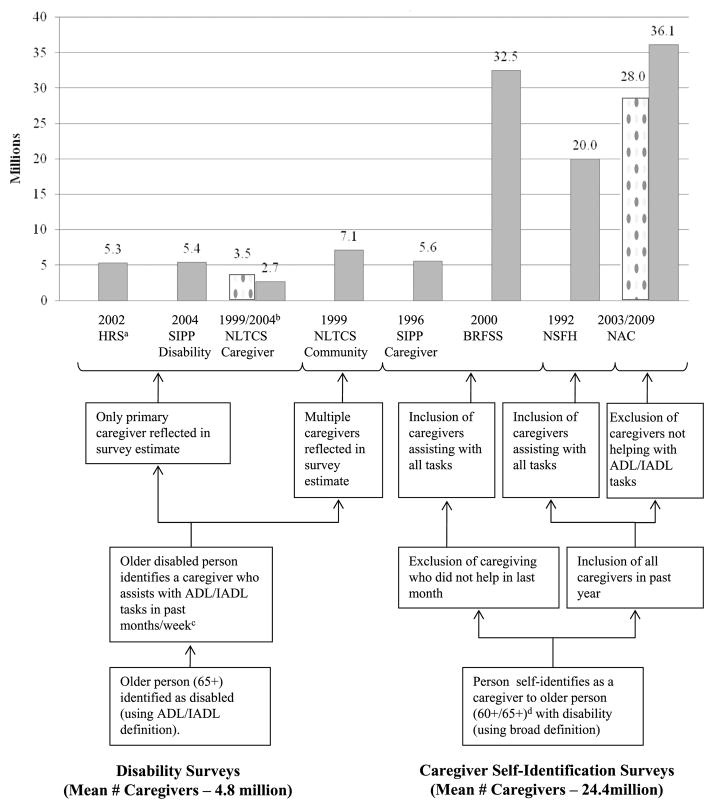FIGURE 1.
Estimated Number of Caregivers of Older Adults in the United States from National Surveys.
Notes: Published weighted estimates of the number of caregivers of older adults in the United States ranged from 2.7 million to 36.1 million. Several factors in the survey design were associated with variation in the estimates. Surveys in which caregivers self-identified resulted in larger published estimates (mean estimate of 24.4 million) than did surveys in which caregivers were identified by a disabled individual (mean estimate of 4.8 million caregivers).
aSources of weighted estimates: (1) 2002 HRS: inferred from the number of adults 65+ reporting receiving help with ADL and IADL tasks (Johnson and Wiener 2006); (2) 2004 SIPP-Disability: inferred from estimated number of community residents aged 65+ receiving help with ADL/IADL tasks (Kaye, Harrington, and LaPlante 2010); (3) 1999 NLTCS-CG: estimated number of primary caregivers of adult 65+ obtained from the profile published by Wolff and Kasper (2006); (4) 2004 NLTCS-CG: estimated number of caregivers of adults aged 65+ reported in study by Hong (2010); (5) 1999 NLTCS-Community: estimated number of caregivers of adults 65+ drawn from the National Family Caregiver Support Program Resource Guide (U.S. Administration on Aging 2002); (6) SIPP-Caregiver: estimate of caregivers interviewed in wave 7 of 1996 SIPP survey obtained from the National Family Caregiver Support Program Resource Guide; however the report did not specify what proportion of the 9.4 million caregivers provided assistance solely to older adults. Therefore, the estimate of 5.6 million is the number of caregivers who self-identified as caring for a parent (1.5 million), spouse (1.4 million), neighbor (750,000), or other relative (2 million) and excludes individuals caring for a child (2.4 million) or cases in which the relationship was not identified (1.4 million). This estimate is therefore likely an overestimate, as it includes caregivers of younger adults (Alecxih, Zeruld, and Olearczyk 2001); (7) NSFH: estimate was reported as 11% of the adult population in 1990 (184.8 million community-dwelling adults in 1990, according to U.S. Census data) caring for an adult 65+ (Marks 1996); (8) 2003 NAC: calculated from the published report of 63% of the total caregiving population (reported as 44.4 million) caring for an adult 65+ (NAC and AARP 2004); (9) 2009 NAC: calculated from the published report of 83% of the total care of someone 50+ (reported as 43.5 million) caring for an adult aged 65+ (NAC and AARP 2009); (10) BRFSS: reported as 15.56% of the adult population in 2000 (209.1 million community-dwelling adults in 2000, according to U.S. Census data) providing care for an adult 60+ (CDC 2000).
bThe 2004 NLTCS-CG survey analysis (Hong 2010) used a different weighting scheme from the 1999 NLTCS-CG survey analysis (Wolff and Kasper 2006); therefore, the estimates are not comparable over time.
cHelp was assessed over four months SIPP-Disability, past week in NLTCS-Community and NLTCS-CG, and not specified in the HRS.
dWhen possible, estimates were restricted to caregivers of adults aged 65 and older; however, in the BRFSS and the SIPP-CG, this was not possible (see note a for more details).

